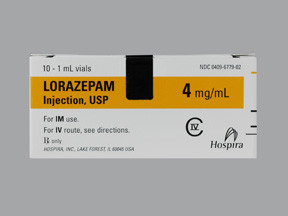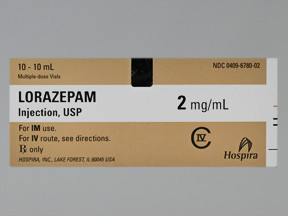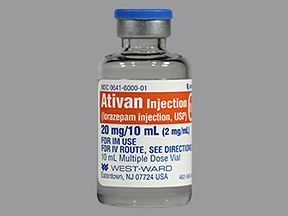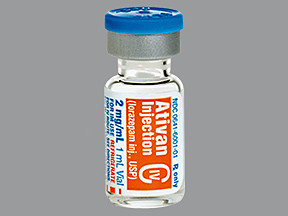LORAZEPAM - INJECTION
PHONETIC PRONUNCIATION: (lor-AZ-e-pam)
COMMON BRAND NAME(S): Ativan
GENERIC NAME(S): lorazepam
Uses
USES: This medication is used to treat serious seizures that do not stop (status epilepticus). It is also used before surgeries or procedures to cause drowsiness, decrease anxiety, and cause forgetfulness about the procedure or surgery. Lorazepam belongs to a class of medications called benzodiazepines, which produce a calming effect on the brain and nerves (central nervous system). It is thought to work by increasing the effect of a certain natural chemical (GABA) in the brain.
How to use LORAZEPAM - INJECTION
HOW TO USE: This medication is given by injection into a vein or muscle as directed by your doctor. The dosage is based on your medical condition, age, and response to treatment. If you are giving this medication to yourself at home, learn all preparation and usage instructions from your health care professional. Before using, check this product visually for particles or discoloration. If either is present, do not use the liquid. Learn how to store and discard medical supplies safely. This medication may cause withdrawal reactions, especially if it has been used regularly for a long time or in high doses. Withdrawal symptoms (such as loss of appetite, trouble sleeping, nausea, vomiting, diarrhea, seizures, mental/mood changes such as anxiety/agitation) may occur if you suddenly stop using this medication. To prevent withdrawal reactions, your doctor may reduce your dose gradually. Report any withdrawal reactions right away. Though it helps many people, this medication may sometimes cause addiction. This risk may be higher if you have a substance use disorder (such as overuse of or addiction to drugs/alcohol). Take this medication exactly as prescribed to lower the risk of addiction. Ask your doctor or pharmacist for more details. Do not suddenly stop using this drug without consulting your doctor. Some conditions may become worse when this drug is abruptly stopped. Your dose may need to be gradually decreased. When this medication is used for a long time, it may not work as well. Talk with your doctor if this medication stops working well. Tell your doctor if your condition persists or worsens.
Side Effects
Precautions
Interactions
Overdose
Images
Reviews
Faq for LORAZEPAM - INJECTION
Lorazepam injection is used to treat anxiety disorders and provide sedation before medical procedures.
Lorazepam injection works by enhancing the effects of a natural chemical in the body called gamma-aminobutyric acid (GABA), which helps to calm the brain and nerves.
The recommended dosage of Lorazepam injection varies depending on the individual's condition and response to treatment. It is usually administered by a healthcare professional.
Common side effects of Lorazepam injection may include drowsiness, dizziness, and weakness. More serious side effects may include difficulty breathing, severe drowsiness, and confusion. It is important to seek medical attention if these side effects occur.
Yes, Lorazepam injection has the potential to be habit-forming, especially if used for a prolonged period or at high doses. It is important to follow the prescribed dosage and duration of treatment to minimize the risk of dependence.
Lorazepam injection should be used with caution during pregnancy and breastfeeding. It may cause harm to the fetus or newborn. It is essential to discuss the potential risks and benefits with a healthcare professional.
Avoid consuming alcohol or using other central nervous system depressants while using Lorazepam injection, as it can increase the sedative effects and lead to excessive drowsiness or respiratory depression.
Yes, Lorazepam injection is a prescription medication and can only be obtained with a valid prescription from a healthcare professional.
Lorazepam injection may be used for short-term treatment of acute insomnia. However, it is usually not the first-line choice and should only be used under the guidance of a healthcare professional.
Warning
WARNING: Using lorazepam with opioid medications (such as codeine, hydrocodone) may increase your risk of very serious side effects, including death. To lower your risk, your doctor should have you use the smallest dose of lorazepam that works, and use it for the shortest possible time. Get medical help right away if any of these very serious side effects occur: slow/shallow breathing, unusual lightheadedness, severe drowsiness/dizziness, difficulty waking up.
Disclaimer
IMPORTANT: HOW TO USE THIS INFORMATION: This is a summary and does NOT have all possible information about this product. This information does not assure that this product is safe, effective, or appropriate for you. This information is not individual medical advice and does not substitute for the advice of your health care professional. Always ask your health care professional for complete information about this product and your specific health needs.








No Reviews Yet